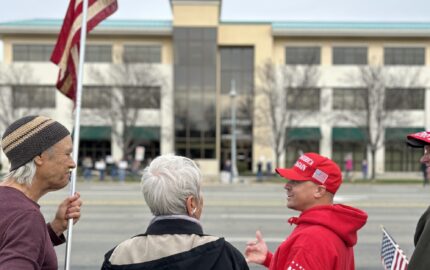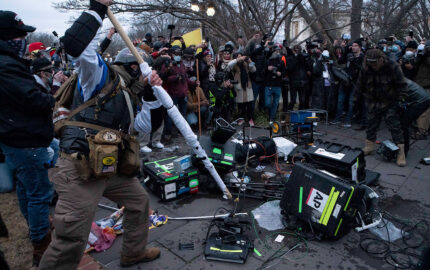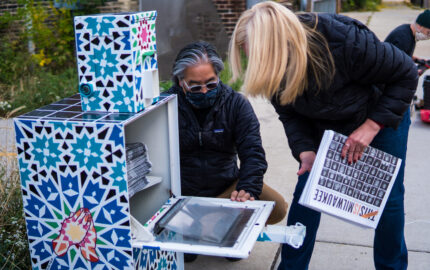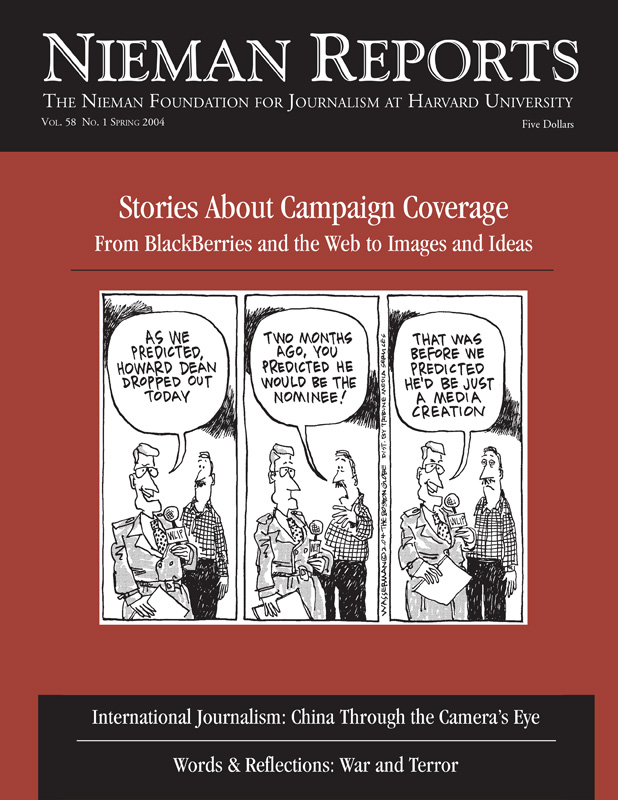
Stories About Campaign Coverage
In his essay “Only a Lunatic Would Do This Kind of Work,” David M. Shribman, executive editor of the Pittsburgh Post-Gazette, captures the essence of what motivates political journalists. “They have an ethos,” Shribman writes. “They believe in inquiry. They believe in the value of the pointed question. They believe in catching their prey in an unscripted moment or in a lie. They believe in asking impertinent questions of their social betters. They believe small deviations from a candidate’s basic stump speech have grave implications.” – Melissa Ludtke, Editor
These days it is difficult to find anything but flattering photographs of any Democratic presidential candidate in the newspaper. Hugging babies, kissing grandmas, and flashing the proverbial thumbs up make up the daily collection of photographs filed from the campaign trail. But are these images as spontaneous and genuine as they appear to be?
The answer is no. Political operatives use increasingly sophisticated techniques to give candidates the most favorable media exposure possible. And the result is a lessening of the credibility that newspapers can offer readers in accurately portraying who the candidates are and what their campaigns are about. The ubiquitous “photo-op” images make this problem more transparent and troubling.
Ever since President Ronald Reagan’s circle of media advisors set out to transform events into carefully choreographed visual experiences, rarely does any major candidate appear without an advance team having prestaged the location. By the time the candidate arrives with the press photographers, there are strategically placed placards with catchy slogans and either a huge American flag or lots of smaller flags in place, and the effect is amplified by lighting professionals. This preparation makes it nearly impossible to avoid emerging from the event with an image the campaign wants to convey.
In most cases, campaign handlers are there to advise photographers about what the “throw,” or the distance from their shooting positions to the candidate, will be. Handlers have even told photographers before they get to their assigned spot how long of a lens will be necessary from that position. In some cases, certain photographers are granted predetermined, strategic positions away from the pen where other photographers are stationed.
In fairness, candidates do make impromptu stops and visits in the frenzy of the daily campaign. And these spontaneous moments, these candid slices of life, make for better documentary photographs. But at the end of a reporting day, when most newspaper editors need to make decisions about what the paper’s political coverage is going to look like, these more candid pictures usually don’t win out over the more elaborate, well-crafted photo op from a scheduled campaign stop where a speech was made or a major rally held.
The impact that news photography has on readers is as vital to a newspaper’s mission as are the words its reporters write. When editors make decisions day after day to publish photographs that are conspicuously photo ops, over time they send a message to readers about the kind of images they think worthy of publication. Such a cavalier approach to the photo editing process strikes at the integrity of the newspaper.
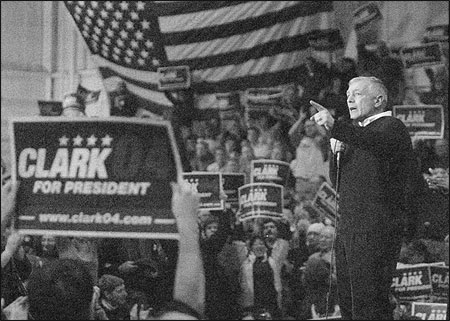
Wesley Clark gestures to supporters during a campaign stop in Pembroke, New Hampshire. The Miami Herald did not publish this photograph: The oversized American flag adorns the back wall, and the only visible face is that of the candidate. The audience is too far away to be in focus. The positioned campaign signs frame Clark nicely. Photo by Charles Dharapak/Courtesy of The Associated Press.
The Photo-Op Dilemma
Of course, there will be days when the only photograph relevant to the news story of the day is limited to a photo op. Then the decision isn’t difficult. “If it is the only photo you have, you go with it,” said Joe Elbert, assistant managing editor/photography at The Washington Post. “However, the burden is on us [as editors] to be more discriminating about the photo selection.” Yet as Elbert acknowledged, the constant deadline pressures and daily demands on photo editors to produce relevant, newsworthy images can leave little or no time for meaningful discussions regarding the photographs’ impact on readers. Elbert refuses to publish photographs from staged events; the Post does not have a fulltime White House photographer and covers the White House only when heads of state visit Washington. Elbert said that the newspaper mostly relies on the major news services to determine what it will use in its daily campaign photo coverage.
There is one question that at some time most newspapers will have to deal with: How does a photo editor—or more importantly, a newspaper—address the ethical dilemma presented by a “must have” photograph when the editor knows it is nothing more than a “photo op” that puts the candidate in a favorable light?
Executive editor of The Miami Herald, Tom Fiedler, is a veteran of the national political wars dating back to his days of reporting from the campaign bus and also serving as the editor of the newspaper’s editorial page. Covering a presidential candidate “is the hardest assignment a news photographer can get,” said Fiedler. “Sometimes you are stuck with the photograph the campaign wants you to have.” When it is apparent that campaign handlers controlled the situation, an editor must decide whether the overall tone of the photograph or the nuance of the captured moment deliver an accurate message. For such occasions, an editor can have a written policy dictating that the use of such a photograph must be fully discussed before a decision is made. Once a decision is reached, the deliberations should be documented as precedent to help shape a response to similar situations in the future. Concern about the perception of bias toward a candidate should be the overriding criteria in deciding to publish or not publish a particular photograph.
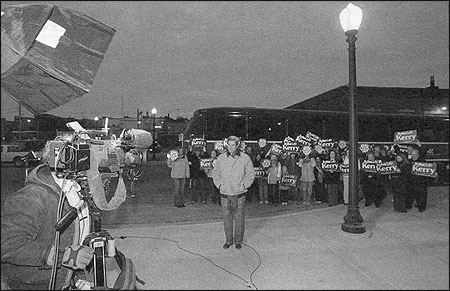
This photograph of Senator John Kerry at a rally in Waverly, Iowa, is staged for the television cameras and photographers. The Miami Herald did not publish this photograph: Kerry’s supporters hold campaign signs, and his campaign bus serves as the backdrop for the candidate and his message. Photo by Jeff Haynes/Courtesy of AFP.
Covering the President
A first-term President is perpetually running for reelection and therefore is looking for images that convey the qualities of his leadership. On two occasions last year, President Bush got help from reporters and photographers in doing just this. In May, the President showed himself acting as a wartime commander in chief when he landed on the USS Abraham Lincoln in the Pacific Ocean to address the troops heading home after the Iraq War. He approached the aircraft carrier at the controls of an S-3B Viking, though the plane’s pilot landed the plane. He then emerged onto the deck dressed like a “Top Gun” pilot, an image that was transmitted around the world.
The second of these occasions was during the President’s high-secret and later much-publicized Thanksgiving Day event at the Baghdad airport. The image of that day was of a smiling President carrying a large turkey on a platter to hungry but wildly enthusiastic troops. Little did it matter that days later the national media revealed that the turkey dinner the President posed with was, in fact, only there for decoration. Stars and Stripes also reported that the cheering soldiers were prescreened and some who had shown up for the meal were turned away. Photo editors walk a fine line when covering an incumbent during a presidential election year. The photographs they publish should help readers to make the distinction between Bush’s official function as President and his role as the candidate for the Republican Party. These two news events blurred those lines. Even though nearly every newspaper published both of these photographs, many editors were left feeling as though they were misleading their readers because of the staging of the events.
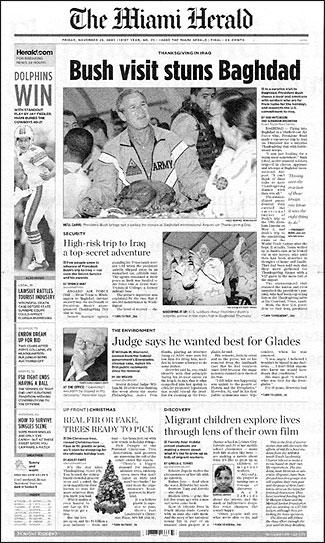
The Miami Herald published the wire photograph of President Bush visiting the U.S. troops for Thanksgiving dinner at a Baghdad airport. Bush kept his visit secret from even his closest advisers. The surprise trip and subsequent photo op were later criticized by the national media. Photo courtesy of The Miami Herald.
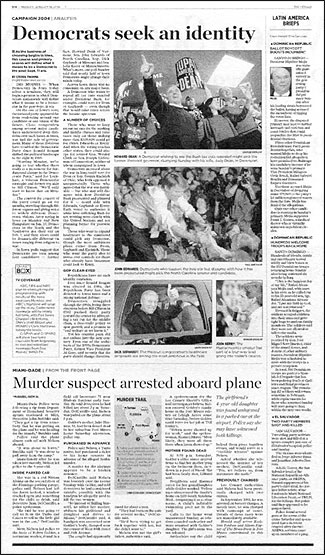
On the final day of campaigning for the Iowa caucuses, The Miami Herald published photos of the four Democratic frontrunners on the jump page. The newspaper’s coverage was balanced in its photo selection and play of Governor Howard Dean, Senator John Edwards, Representative Richard Gephardt, and Senator John Kerry. Being fair does not mean that all the photos have to be the same size and dimension. Photo courtesy of The Miami Herald.
The Digital Revolution
Nowadays, speed is of the essence on the campaign trail, but it makes for a bumpy ride for photographers when it comes to accurate and responsible coverage. The days of campaigns unfolding at a slower pace are gone, along with the Telex and fax machines once used to transmit stories back to newspapers, as well as the rewrite desks for taking dictation from reporters. New and speedier technologies are imperative for reporters and photographers if they are going to work in the dynamic environment of these modern-day campaigns when candidates are on the road from daybreak into the late hours of the night, and media coverage is their constant companion.
The impact of new technologies on those who use them and those who receive their product is nowhere as evident as it is with photography. The digital revolution in photography, coupled with the increasing use of wireless transmission, makes some aspects of the newsgathering almost seamless. However, for photographers, these technological changes mean that their work is more labor-intensive and their time more pressured. To meet early deadlines, photographers rush to shoot, rush to download, and rush to edit, caption and transmit what they’ve shot for their newspapers or news agencies. Rarely do they have the luxury of time to reflect on the relative importance of the numerous events they are shooting. Sometimes a political rally becomes little more than a blur in the viewfinder by the end of a 16-hour day. Given these circumstances, newspaper editors—both print and photography—are obligated to make accurate and fair decisions about how to convey and display the day’s coverage. To do this, editors ask themselves some very difficult questions. These include:
In its daily coverage—or even in the course of a week—newspapers cannot give equal play to the entire field of Democratic presidential contenders. What editors should strive to do is to visually capture what they understand is the defining message from that day’s campaign trail. It is a misguided attempt if editors try to have the paper’s photographic coverage be all-inclusive, for example, by publishing as many candidates’ photos as possible on a given day. To do so means that newspapers end up misconstruing the idea of “balanced coverage” that was never intended to mean “when you run one candidate, run ’em all.” Yet there will be days—such as the final day of campaigning in Iowa—when it might make sense to show all of the leading contenders. In that case, “fair and balanced” does not mean that each photo needs to be the same size.
Improved planning for daily and weekly photography coverage also helps editors avoid having to run a prestaged photo op simply because the newspaper is compelled to run that particular candidate on that day. The need to do “Day in the Life” photography essays on the candidates is as crucial as the obligatory profiles that most newspapers run on the candidates. Doing such essays helps to offset the staged photo ops that grow more intense as the Iowa caucuses and New Hampshire primary near. Editors would be wise, too, to find alternative sources to the traditional wire services such as The Associated Press, Agence France-Press, and Reuters that now provide the brunt of the photography. Daily and weekly newspapers and other news outlets reporting from their respective cities can be helpful in sometimes providing a more critical and fresh eye.
Luis Rios is director of photography at The Miami Herald.
The answer is no. Political operatives use increasingly sophisticated techniques to give candidates the most favorable media exposure possible. And the result is a lessening of the credibility that newspapers can offer readers in accurately portraying who the candidates are and what their campaigns are about. The ubiquitous “photo-op” images make this problem more transparent and troubling.
Ever since President Ronald Reagan’s circle of media advisors set out to transform events into carefully choreographed visual experiences, rarely does any major candidate appear without an advance team having prestaged the location. By the time the candidate arrives with the press photographers, there are strategically placed placards with catchy slogans and either a huge American flag or lots of smaller flags in place, and the effect is amplified by lighting professionals. This preparation makes it nearly impossible to avoid emerging from the event with an image the campaign wants to convey.
In most cases, campaign handlers are there to advise photographers about what the “throw,” or the distance from their shooting positions to the candidate, will be. Handlers have even told photographers before they get to their assigned spot how long of a lens will be necessary from that position. In some cases, certain photographers are granted predetermined, strategic positions away from the pen where other photographers are stationed.
In fairness, candidates do make impromptu stops and visits in the frenzy of the daily campaign. And these spontaneous moments, these candid slices of life, make for better documentary photographs. But at the end of a reporting day, when most newspaper editors need to make decisions about what the paper’s political coverage is going to look like, these more candid pictures usually don’t win out over the more elaborate, well-crafted photo op from a scheduled campaign stop where a speech was made or a major rally held.
The impact that news photography has on readers is as vital to a newspaper’s mission as are the words its reporters write. When editors make decisions day after day to publish photographs that are conspicuously photo ops, over time they send a message to readers about the kind of images they think worthy of publication. Such a cavalier approach to the photo editing process strikes at the integrity of the newspaper.

Wesley Clark gestures to supporters during a campaign stop in Pembroke, New Hampshire. The Miami Herald did not publish this photograph: The oversized American flag adorns the back wall, and the only visible face is that of the candidate. The audience is too far away to be in focus. The positioned campaign signs frame Clark nicely. Photo by Charles Dharapak/Courtesy of The Associated Press.
The Photo-Op Dilemma
Of course, there will be days when the only photograph relevant to the news story of the day is limited to a photo op. Then the decision isn’t difficult. “If it is the only photo you have, you go with it,” said Joe Elbert, assistant managing editor/photography at The Washington Post. “However, the burden is on us [as editors] to be more discriminating about the photo selection.” Yet as Elbert acknowledged, the constant deadline pressures and daily demands on photo editors to produce relevant, newsworthy images can leave little or no time for meaningful discussions regarding the photographs’ impact on readers. Elbert refuses to publish photographs from staged events; the Post does not have a fulltime White House photographer and covers the White House only when heads of state visit Washington. Elbert said that the newspaper mostly relies on the major news services to determine what it will use in its daily campaign photo coverage.
There is one question that at some time most newspapers will have to deal with: How does a photo editor—or more importantly, a newspaper—address the ethical dilemma presented by a “must have” photograph when the editor knows it is nothing more than a “photo op” that puts the candidate in a favorable light?
Executive editor of The Miami Herald, Tom Fiedler, is a veteran of the national political wars dating back to his days of reporting from the campaign bus and also serving as the editor of the newspaper’s editorial page. Covering a presidential candidate “is the hardest assignment a news photographer can get,” said Fiedler. “Sometimes you are stuck with the photograph the campaign wants you to have.” When it is apparent that campaign handlers controlled the situation, an editor must decide whether the overall tone of the photograph or the nuance of the captured moment deliver an accurate message. For such occasions, an editor can have a written policy dictating that the use of such a photograph must be fully discussed before a decision is made. Once a decision is reached, the deliberations should be documented as precedent to help shape a response to similar situations in the future. Concern about the perception of bias toward a candidate should be the overriding criteria in deciding to publish or not publish a particular photograph.

This photograph of Senator John Kerry at a rally in Waverly, Iowa, is staged for the television cameras and photographers. The Miami Herald did not publish this photograph: Kerry’s supporters hold campaign signs, and his campaign bus serves as the backdrop for the candidate and his message. Photo by Jeff Haynes/Courtesy of AFP.
Covering the President
A first-term President is perpetually running for reelection and therefore is looking for images that convey the qualities of his leadership. On two occasions last year, President Bush got help from reporters and photographers in doing just this. In May, the President showed himself acting as a wartime commander in chief when he landed on the USS Abraham Lincoln in the Pacific Ocean to address the troops heading home after the Iraq War. He approached the aircraft carrier at the controls of an S-3B Viking, though the plane’s pilot landed the plane. He then emerged onto the deck dressed like a “Top Gun” pilot, an image that was transmitted around the world.
The second of these occasions was during the President’s high-secret and later much-publicized Thanksgiving Day event at the Baghdad airport. The image of that day was of a smiling President carrying a large turkey on a platter to hungry but wildly enthusiastic troops. Little did it matter that days later the national media revealed that the turkey dinner the President posed with was, in fact, only there for decoration. Stars and Stripes also reported that the cheering soldiers were prescreened and some who had shown up for the meal were turned away. Photo editors walk a fine line when covering an incumbent during a presidential election year. The photographs they publish should help readers to make the distinction between Bush’s official function as President and his role as the candidate for the Republican Party. These two news events blurred those lines. Even though nearly every newspaper published both of these photographs, many editors were left feeling as though they were misleading their readers because of the staging of the events.

The Miami Herald published the wire photograph of President Bush visiting the U.S. troops for Thanksgiving dinner at a Baghdad airport. Bush kept his visit secret from even his closest advisers. The surprise trip and subsequent photo op were later criticized by the national media. Photo courtesy of The Miami Herald.

On the final day of campaigning for the Iowa caucuses, The Miami Herald published photos of the four Democratic frontrunners on the jump page. The newspaper’s coverage was balanced in its photo selection and play of Governor Howard Dean, Senator John Edwards, Representative Richard Gephardt, and Senator John Kerry. Being fair does not mean that all the photos have to be the same size and dimension. Photo courtesy of The Miami Herald.
The Digital Revolution
Nowadays, speed is of the essence on the campaign trail, but it makes for a bumpy ride for photographers when it comes to accurate and responsible coverage. The days of campaigns unfolding at a slower pace are gone, along with the Telex and fax machines once used to transmit stories back to newspapers, as well as the rewrite desks for taking dictation from reporters. New and speedier technologies are imperative for reporters and photographers if they are going to work in the dynamic environment of these modern-day campaigns when candidates are on the road from daybreak into the late hours of the night, and media coverage is their constant companion.
The impact of new technologies on those who use them and those who receive their product is nowhere as evident as it is with photography. The digital revolution in photography, coupled with the increasing use of wireless transmission, makes some aspects of the newsgathering almost seamless. However, for photographers, these technological changes mean that their work is more labor-intensive and their time more pressured. To meet early deadlines, photographers rush to shoot, rush to download, and rush to edit, caption and transmit what they’ve shot for their newspapers or news agencies. Rarely do they have the luxury of time to reflect on the relative importance of the numerous events they are shooting. Sometimes a political rally becomes little more than a blur in the viewfinder by the end of a 16-hour day. Given these circumstances, newspaper editors—both print and photography—are obligated to make accurate and fair decisions about how to convey and display the day’s coverage. To do this, editors ask themselves some very difficult questions. These include:
- What is the big picture and story we should be offering readers the next morning?
- Are the photographs a representative and accurate interpretation of the day’s developments?
- How has the newspaper played similar photographs and situations in the past days or weeks?
- Are the photographs filed by the news agencies becoming redundant in the tone and message that they are projecting?
- Is the distribution of space for these images being done in direct relation to the news and those candidates making the news?
- Are certain photographs really what they appear to be?
- Is a photograph calling undue and not newsworthy attention to a situation or candidate because of its composition and artistry?
In its daily coverage—or even in the course of a week—newspapers cannot give equal play to the entire field of Democratic presidential contenders. What editors should strive to do is to visually capture what they understand is the defining message from that day’s campaign trail. It is a misguided attempt if editors try to have the paper’s photographic coverage be all-inclusive, for example, by publishing as many candidates’ photos as possible on a given day. To do so means that newspapers end up misconstruing the idea of “balanced coverage” that was never intended to mean “when you run one candidate, run ’em all.” Yet there will be days—such as the final day of campaigning in Iowa—when it might make sense to show all of the leading contenders. In that case, “fair and balanced” does not mean that each photo needs to be the same size.
Improved planning for daily and weekly photography coverage also helps editors avoid having to run a prestaged photo op simply because the newspaper is compelled to run that particular candidate on that day. The need to do “Day in the Life” photography essays on the candidates is as crucial as the obligatory profiles that most newspapers run on the candidates. Doing such essays helps to offset the staged photo ops that grow more intense as the Iowa caucuses and New Hampshire primary near. Editors would be wise, too, to find alternative sources to the traditional wire services such as The Associated Press, Agence France-Press, and Reuters that now provide the brunt of the photography. Daily and weekly newspapers and other news outlets reporting from their respective cities can be helpful in sometimes providing a more critical and fresh eye.
Luis Rios is director of photography at The Miami Herald.
